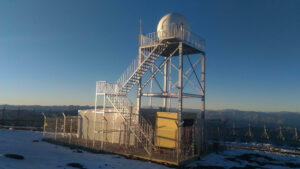At Volo Radome, we specialize in building different types of radomes. But what exactly is a radome? How does it work? Let’s take a look.
What is Radom?
Radom is a weatherproof housing that protects a radar system or antenna and is made of material that weakens the electromagnetic signal transmitted or received by the antenna as little as possible. Radoms protect antenna surfaces from elements and/or hide antenna electronic equipment from the public eye. Weather radar, air traffic control, satellite communications, and telemetry are just a few of the applications that specialized radome manufacturers like us provide radomes.

Radom
Radoms come in a variety of shapes and sizes. The use of various building materials is determined by the specific application or frequency. Radome Services LLC teams have extensive experience with all types of radomes, including dielectric, space frame, composite, and air-inflatable radomes mounted on the ground, towers, roofs, and ships.
The term radom is a combination of radar and dome.
This protective shell should reflect electromagnetic radiation as little as possible, absorb, break or scatter, and at the same time have the lowest possible conduction attenuation. The attenuation of a raduma for radar units affects both the sending and receiving routes. That’s why it’s called “two-way slimming.” A typical value for two-way attenuation for a foamed radome is a total of about 0% of the high-frequency energy.

is 3.7 dB, which represents its loss. According to the radar equation, this means a 2% loss in range.
When did Radome first appear?
Walter Bird built the first air-assisted radome model in 1946. These air-supported domes were completely spherical and functioned like a large balloon above the radar system. This first radome was made possible by advances in fabric technology that included a neoprene-coated fiberglass cloth.
New materials with better architectural properties created new opportunities for air-assisted construction. Radomes were a useful tool that allowed us to do something with fabric and air that was previously thought impossible.
Ground Radom Varieties
Composite Radoms: A sandwich radome, for example, is a composite radome. A spherical dome consists of double-curved panels that form a rigid, self-supporting shell structure with two shells.
Air-Assisted Radomes: Air-assisted radomes are a flexible fabric envelope that must be inflated at all times. This device works on uninterruptible power and backup blower systems. This envelope cloth has the best RF performance.

Space Frame Radomes: The space frame radome is a rigid, self-supporting structure composed of triangular panels joined to form a geodesic dome. This type of radome is commonly used in severe weather conditions.
What Materials Are Used to Make Radomes?
The material used is critical. However, not all materials are equally suitable for radome design. When radar waves strike an object or person, the properties of the surface at the point of contact affect their propagation and reflection. Some materials are easily penetrated, while others reflect or absorb them excessively.
A radome’s purpose is to protect the antenna while allowing as little signal strength loss as possible. Because metal is highly reflective, it cannot be used in a radome. Even wooden radomes would be problematic because they only allow a limited amount of radar pulses to pass through.
Polystyrene foams, on the other hand, are fantastic at hiding the front end. They could even go on top of the antenna. However, due to their poor stability and sensitivity to chemicals, they may have a negative impact on the protective function of the housing. other radomes: Radome

